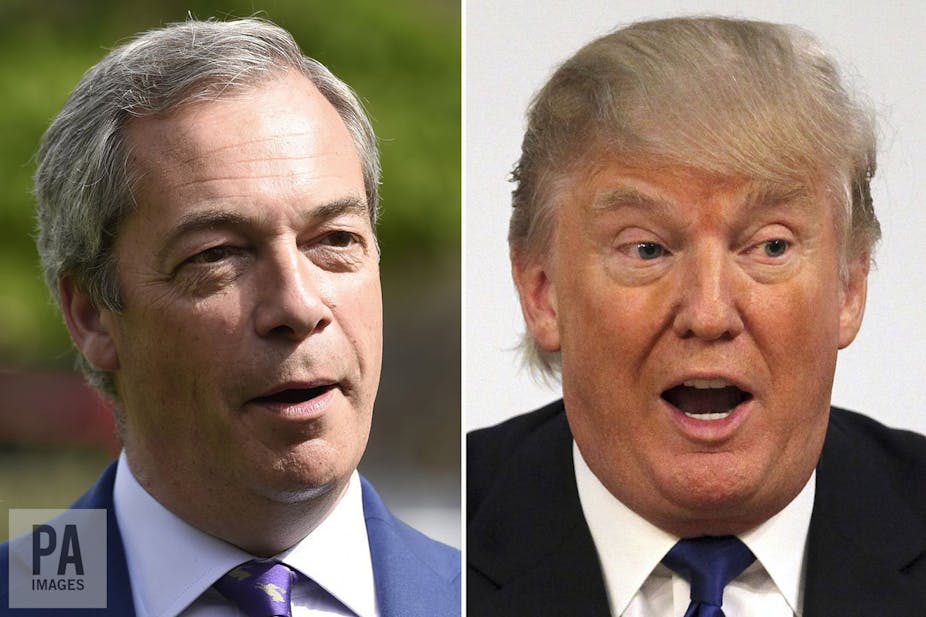Far-right movements are clearly on the rise throughout Europe and the US. Winning elections in the US and campaigns to leave the European Union are providing an effective boost to charismatic public figures clutching a populist ticket and claiming to be outside of the establishment.
And in two major events of 2016 – Donald Trump’s election and Brexit – far-right movements have leveraged social media far more effectively than their opposition.
The “alternative right” or alt-right, has made expert use of blogs, tweets, hashtags, memes, and trolling to provide a legitimised voice to far-right ideas – and to use that voice to speak to huge amounts of people.
A nebulous collection of internet-savvy individuals who came to prominence in support of Trump’s presidency, the alt-right represents various right-leaning ideologies including white supremacy, Islamophobia, homophobia, anti-Semitism, anti-feminism and opposition to immigration.
Meanwhile the left’s social media usage seems to come across somewhat differently. Undoubtedly there are left-leaning campaigns gaining effective and vital support through social media – the Scottish National Party’s presence on Twitter for example, or the polished Facebook page of Pablo Iglesias (leader of the radical left-wing Spanish political party Podemos) which has compared Spanish politics to Game of Thrones.
But there are notable differences in how the social media usage of the left and right are reported and thought about in wider culture. There are innumerable reports exploring, in depth, Donald Trump’s Twitter timeline (which then adds to his social media presence, while a lack of coverage restricts social media growth).
Some say Hillary Clinton’s supporters even assisted her defeat by choosing to insult Trump supporters online rather than engage them in serious debate. British commentator Jonathan Freedland argued that Brexit Remainers have done little more than “exchange ironic, world-weary tweets, the electronic equivalent of a sigh, each time they read of some new hypocrisy or deception by the forces of leave”.
Given this imbalance, what might the left do to make better use of social media? Imitating the dubious strategies of the “alt-right” with an “alt-left” counterweight is probably not a positive move. (Remember that “alt-right” as a term and movement has its origins in the writings of Richard Spencer, president of white supremacist think-tank The National Policy Institute.)
Rather, what the left might benefit from is an examination of its own social media success stories.
One example is the @StopFundingHate campaign. This Twitter account (with 66,000 followers) encourages consumer pressure against companies which spend money advertising in right-wing publications such as the Daily Mail (which, it is argued, provide platforms for divisive social ideologies). So far its biggest victory has been Lego’s decision to end free giveaways through that newspaper.

To find out why the this particular Twitter account had sparked so much public interest, we analysed tweets featuring the #StopFundingHate hashtag with colleagues at Newcastle and Northumbria universities. As part of the CuRAtOR project, we work on investigating the cultures of fear that are propagated through online “othering” and how this can lead to subsequent mistrust and stigmatisation of groups or communities.
We found a large concentration of tweets around the sharing of a video produced by the campaign which plays on the British tradition of emotive Christmas TV adverts.
The seasonal ads usually attempt to associate positive traditional Christmas values – togetherness, goodwill, family – with the company’s products and services.
The @StopFundingHate video overlays clips from these adverts with text that juxtaposes their feel-good sentiment against the apparently divisive content of newspapers these same companies choose to advertise with.
Tweets that shared this video also often use a word, “brandjamming”, to succinctly describe the video’s aim in a single snappy term. That aim is to leverage consumer power against retailers by publicly pressuring them into cutting financial ties with sections of the news media.
One key element of the campaign’s success was its timing. It appeared in the lead up to Christmas, when emotions are stirred and consumers have power. Second, it seems that sharing visually engaging material is more effective than simply tweeting. The video had a simple message which realigned TV adverts we may have previously felt good about.
And while these strategies do not necessarily suggest a message with much longevity or depth, they do work to produce something that resonates with people and which people are motivated to share.
Social(ist) media campaigns
Building on these insights, we also collected the tweets produced by the @StopFundingHate account itself. These often referred back to the campaign’s own larger social media presence, with tweets containing terms like “Facebook”, “following” and “share” – regular reminders for followers to spread the message to non-followers and extend the reach of the campaign.
@StopFundingHate also regularly hijacks hashtags already in use by companies as well as more general Christmas-themed hashtags such as #goodwilltoall. This serves to place the message within more mainstream domains – somebody searching for heart-warming tweets about #bustertheboxer might happen across @StopFundingHate and question the validity of their feelings about the John Lewis advert.
@StopFundingHate uses its account to directly call out companies including @LEGOGroup, @JohnLewisRetail and @Waitrose. In mentioning these companies, the onus is thereby squarely placed on them to respond or, more typically, to be seen as failing to respond to critiques levied directly at them.
Yet it is important to remember that @StopFundingHate is not universally well-received. Just as the “alt-right” have been accused of dubious social media practices (such as trolling opponents, or using personal details in threatening ways), there has been a backlash against this particular campaign for encouraging press censorship.
So for @StopFundingHate and the left generally, a careful balance has to be struck. They need to be seriously committed to social change without being considered as a branch of the thought police.
Nevertheless, to put up stronger opposition against an increasingly institutionalised right, the left needs to analyse and reflect on its use of social media. If it does, it will be able to strike that balance – and apply its successes elsewhere.

